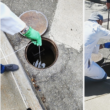The core issues underlying the threat of incapacitants
By Alan Pearson, April 28, 2008
On the issue of incapacitants, my colleagues and I are pretty much in agreement–States Parties to the Chemical Weapons Convention (CWC) should establish clear boundaries between prohibited chemical weapons and toxic chemicals and delivery systems that are permitted for law enforcement purposes. Then they should develop mechanisms to ensure that states abide by their agreements.
Ralf Trapp is concerned that my proposal–that States Parties pursue agreed criteria, standards, and methods to determine whether a toxic chemical or delivery system is consistent with law enforcement purposes–appears to presuppose that states have agreed to discard the "narrow" interpretation of the CWC's law enforcement clause that only riot control agents are allowed. I disagree. Fifteen years of experience has shown that framing the discussion in terms of whether or not law enforcement agents include more than riot control agents has been unproductive. It has enmeshed debates about what agents might be permitted for law enforcement purposes with debates about whether riot control agents are toxic chemicals. These two issues are related, but it would be more productive to put aside the second issue for now in order to focus on the first.
This framing also fails to recognize how advances in science and technology increase the potential for states to seek opportunities within the CWC's definition of a riot control agent. For example, the powerful anesthetic remifentanil, related to the agent used to resolve the Moscow theatre hostage crisis, might well qualify as a riot control agent if one narrowly interprets the CWC. Yet common sense tells us that such an agent would be qualitatively different from the tear gasses and pepper spray that comprise present stockpiles of riot control agents.
For these reasons, it's time to move away from the question of whether law enforcement agents are limited to riot control agents and toward addressing the core principles underlying the CWC. The end result can't be predicted, but such an exercise could find that only agents that are more or less like today's riot control agents meet the agreed criteria and standards. Other outcomes are also possible. But at least the findings would be built on the foundations of the CWC, and all states would be better positioned to control the resulting situation than if they continue to avoid discussion and let developments happen state-by-state.
Tucker suggests that to address incapacitants, States Parties should create a new subcategory for declaring "other chemical production facilities" that manufacture peptides in quantities exceeding a certain threshold. This proposal is intriguing but inadequate, because most of the incapacitating agents of concern are unlikely to be peptides. For example, most of the more than two dozen potential incapacitating agents identified in the Applied Research Laboratory report Tucker initially refers to are non-peptide chemicals.
Both Aas and Trapp point out that developing a verification system for addressing the convergence of chemistry and biology will be extremely challenging. Indeed, the convergence is rendering the chemical weapons problem increasingly like the biological weapons problem, with the number of potential threat agents expanding to the point that traditional means of agent-specific control are becoming inadequate. States need to develop mechanisms to verify compliance with basic CWC prohibitions rather than simply verifying that adherents don't possess a specified list of chemicals. This is a more difficult task, and I agree with Trapp that the CWC was not designed to deal with this situation. Thus states will need to explore other avenues for verification. The central goal must be to find ways of increasing transparency and reporting about chemical activities and holdings, both to other states parties and to the public. The greater the transparency, the more likely non-transparent states will stand out.
A final thought: Even though the Biological and Toxin Weapons Convention does not directly involve incapacitants, biology and biologists certainly will be involved in their development. Researching new incapacitating chemical weapons will require using the latest in biological knowledge and technologies. Life scientists have generally been able to avoid the arms control implications of their fields because the biological weapons problem has largely been perceived as far removed from their work. If states opt to develop incapacitants, scientists will no longer be able to avoid the issue. Then, life scientists individually and as a community will either allow themselves to become enamored with visions of "humane" chemical weapons, as scientists have in the past, or will have to resolutely resist their development.
Topics: Biosecurity
Share: [addthis tool="addthis_inline_share_toolbox"]














